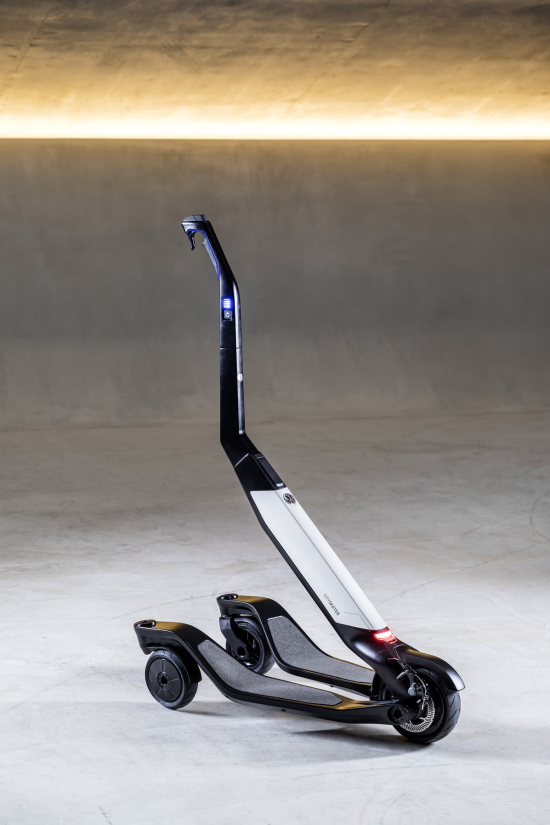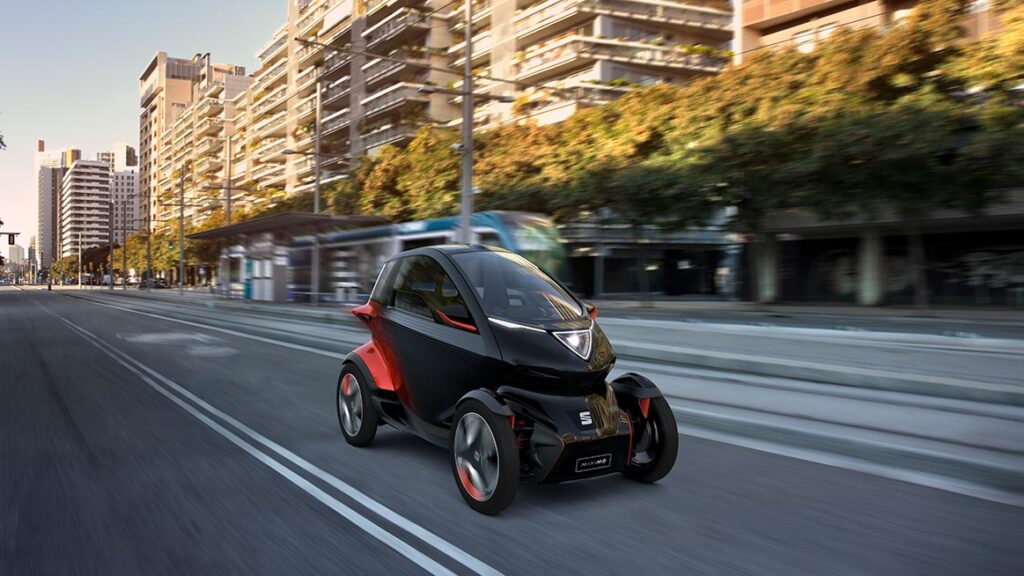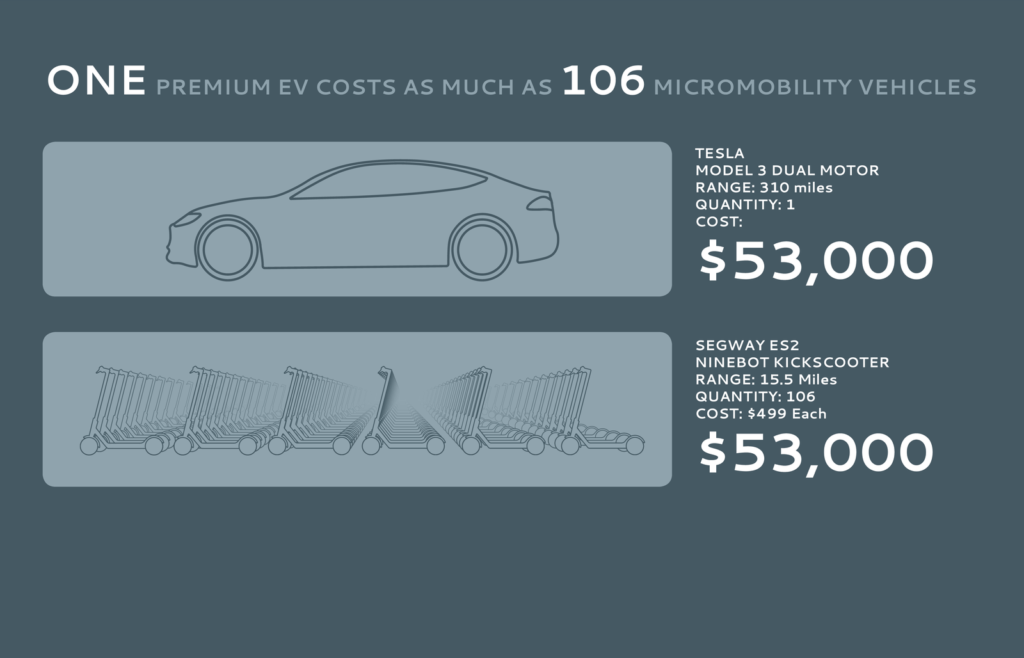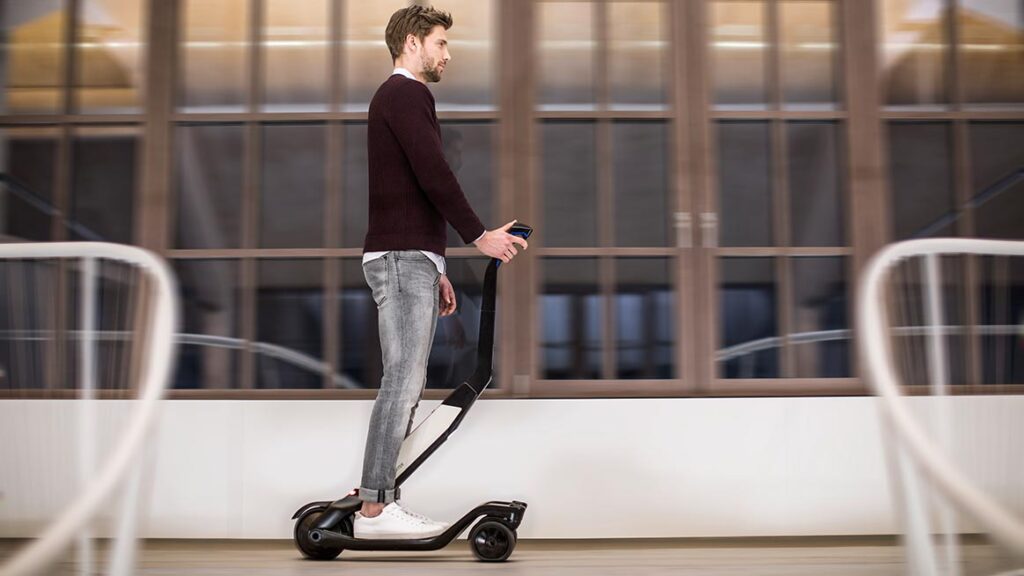Many in the transport sector see the next decade as the age of the electric car. However, despite the importance of this evolution in private vehicles, it might not be the answer to our goal of sustainable living.
 G
G

Many in the transport sector see the next decade as the age of the electric car. However, despite the importance of this evolution in private vehicles, it might not be the answer to our goal of sustainable living.
© Image: the new Volkswagen electric scooter concept Cityskater.
Transportation shapes much of our lives to a point where a lack of adequate transportation significantly restricts economic potential and quality of life. However, transport affects us in ways we might not always consider.
Transport dominates our urban infrastructure with much of the space used to facilitate car travel. This includes roads, car parking spots (both commercial and residential) and fuelling stations. Rather than designing cities in line with human necessities and pleasures, such as green spaces, we have actually surrendered a large percentage of the space to transport vehicles.
So, is there a way to take back control of our cities and protect the environment? The answer could lie with micromobility.
Micromobility is a word used in tech and finance to describe a new concept in urban transportation. In simple terms it means using lightweight electric vehicles, such as e-scooters, to complete trips over short distances.
Micromobility advocates hope that these small vehicles can revolutionise the way we move around the city. For example, if you need to take a 40 minute trip, you will likely consider taking your car. However, with micromobility, you could break up this journey. Potentially, you could rent an e-scooter for 15 minutes, and then ride a train or bus to your final destination.
In this example, the e-scooter has helped you connect to public transport and more importantly, has given you an alternative to a heavily emitting vehicle, the car.
So, what are the other reasons we should embrace micromobility?
Official statistics in the UK show that an estimated 56 percent of all car journeys, taken in 2018, were less than five miles in length (UK Government, 2018). Many of these journeys will have been perfectly manageable on foot or by bicycle. Yet, a majority of people choose to drive leading to a deterioration of our air quality and general levels of physical fitness.
The Environmental Protection Agency in the US explored the hypothetical proposition – what if we kept our cars parked for trips less than one mile? They discovered that the US could stop at least two million metric tons of CO2 from entering the atmosphere per year and save around 400 million dollars in health costs from encouraging more regular exercise.
At Kumēia, we believe that pursuing a more sustainable lifestyle isn’t only beneficial for the planet but can help us enjoy a more fulfilling life. In this instance, the availability of lightweight electric vehicles would allow壯陽藥 us to step away from our reliance on cars and take journeys which are better for our mental and physical health.
In 2018, road transport, consisting of cars, motorcycles and taxis, accounted for three quarters of the total emissions of the global transport sector, which topped out at eight billion tons of CO2 (Our World in Data, 2020). Incorporating more lightweight electric vehicles into the sector will enable us to vastly reduce this emissions total.

In one of the UK’s largest cities, Newcastle, a rental e-scooter company launched a micromobility trial hoping to get locals to change their travel habits. The results of the trial revealed encouraging signs about our willingness to embrace alternative transport – over a third of the users in the trial said they rented an e-scooter to replace a car journey (Forbes, 2021).
Another positive for our carbon footprint, aside from reducing our car usage, is that small vehicles are incredibly energy efficient. In a study published by Wired (Wired, 2018), an e-scooter was tested against a petrol and electric car to see how far each vehicle could travel on one kilowatt hour of energy. The petrol car finished last having only traveled a little over one mile. The electric car managed around four miles and the small e-scooter, way out in front, kept going for more than 80 miles.

Micromobility has the potential to make our cities more habitable by helping us reclaim some much needed space.
Los Angeles, California, is a city defined by its car use. A study conducted in 2018, showed that the city had over 27 square miles dedicated solely to parking lots, an area four times the size of Manhattan (Curbed, 2018). Based on this evidence and current population density, researchers worked out that enough homes could be built on these lots to house 800,000 residents. If even a fraction of this space was converted to housing stock it would help the city ease its devastating homelessness crisis.
Reimagining our cities will not happen overnight and city governments need to address the various teething problems of micromobility. Many urban residents have complained about ‘sidewalk clutter’ as e-scooters users have had to abandon their vehicles due to lack of storage options. These problems however can be solved with small innovations to city planning. Some places have already started to make adjustments. For example, certain cities in the US have repurposed car parking lots to allow small e-scooters to ‘dock’ (Smart Cities Dive, 2021).
Clearly, cutting down on our car use can give us more space to unlock the potential of our cities. But, micromobility isn’t just beneficial on a macro level.

Urban residents in LA and other cities have to pay a high price for car ownership. Not only is the vehicle itself expensive but fuel costs, especially since the onset of the war in Ukraine, have risen to unsustainable levels. The American Automobile Association (AAA), who complete a thorough cost analysis on car ownership in the US, have worked out that financing and running a car in 2022 is five percent more expensive than previous years (AAA, 2022). This includes a price hike in insurance costs, fuel costs and overall maintenance and repair costs.
Renting or purchasing a small e-vehicle is much more economical.
The rise of e-scooters and e-bikes will lead to an optimisation of our public transport services, as public transport is often an integral part of micromobility travel.

During the e-scooter trial in Newcastle, 60 percent of the users said they combined a scooter trip with some form of public transport (Forbes, 2021). This means public transport is key to the success of micromobility and means we need to facilitate more integration between them.
Studies have looked at the impact of micromobility on public transport. The main findings are positive. For example, micromobility can increase the catchment area of bus and train services, giving people in the city more access to new routes. Also it increases the distances people are willing to travel, because they have an option other than walking (International Transport Forum, 2021). Both these changes are beneficial to the city for economic and social reasons.
In some cases, the wide availability of small e-vehicles will make transport services redundant. In a survey conducted in Brussels, 30 percent of e-scooter users said that renting an e-scooter meant they could avoid a public transport trip (Moreau et al., 2020). Losing certain public transport routes might have a negative effect on some residents, likely older and less mobile ones.
Ultimately, the car is not a fit tool for much of our urban travel needs. Transitioning to small electric vehicles is a cost-effective and sustainable way to get around the city.
Micromobility does have some drawbacks. Currently, with city infrastructure aligned to car travel, small electric vehicles and pedestrians compete for the same space on sidewalks and pavements. However, in the long term, micromobility is part of the solution to the lack of space in our cities. With fewer cars, city governments can create large pedestrian exclusive zones and build more housing to improve living conditions.
Intrigued about micromobility? Here are some online resources which give you a clearer picture about the possible future of city transportation.
Désirée is Kumeia's founder. She is dedicated to communicate knowledge that supports the creation of a sustainable lifestyle, and addresses the entrepreneurial motivations of people who want to contribute to the green evolution of our economies.
 G
G
Begin typing your search above and press return to search. Press Esc to cancel.